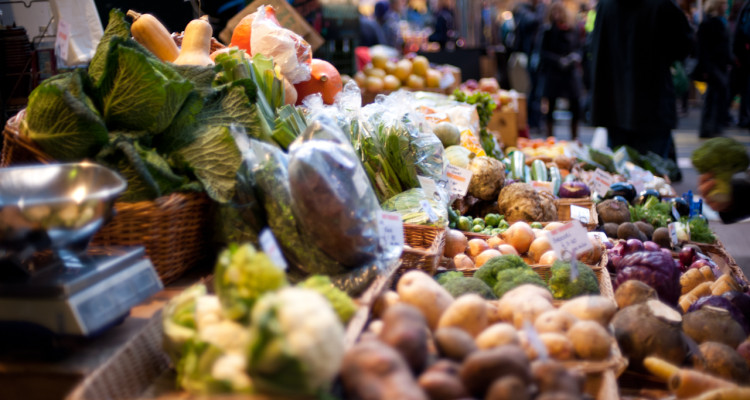Excess still isn’t enough
We shouldn’t be throwing out surpluses of food when there are people in need
Photo courtesy of Scotts Food & Drink
Grocery stores typically have a huge selection of food, however, many of the products are thrown out because of expiration dates, bacteria, mold or cosmetic reasons.
March 3, 2021
Food waste isn’t an unfamiliar thing for most people. It can be seen as homes tossing out wilted vegetables or restaurants throwing away entire portions of food because an order was done incorrectly. While these can be seen as a minor day-to-day habit, these losses in food come at an expense – as more trash is accumulated, and people are still left hungry.
One of the main reasons for individuals going hungry is food insecurity — which is stemmed from poverty and inconsistent access to food. For the people who face this issue, not only do they have to manage the dilemma in an effective way, but they must also make sacrifices. Many times, this results in skipped meals to feed other family members, traveling long distances on foot for some groceries or enduring difficult decisions in terms of which bills to prioritize over the others. While these situations feel uncommon, especially to those living in upper-middle-class areas, the U.S. Department of Agriculture (USDA) found that 10.5% (13.7 million) of U.S. households were food insecure at some time during 2019. Despite these numbers coming from before the pandemic, the consensus is the same as the Institute for Policy Research at Northwestern University established that food insecurity has doubled overall and tripled among households with children. This issue stems from a lack of resources, but there is actually a surplus of food to go around, with the USDA finding 30-40 percent of the food supply goes to waste. Much of this food waste is due to spoilage, but over-ordering and removal of produce for cosmetic reasons also contribute to the problem.
Looking at restaurants, many must follow guidelines in terms of how food must be stored and how long it can be kept; however, in the day-to-day routines for these businesses, food still gets tossed out every day to a certain extent. Food orders that are unclaimed, have been made incorrectly or sent back (untouched) to the kitchen are more than likely thrown away, resulting in a perfectly good meal in the trash. Many times, these items are still in good enough condition to be donated. As Food Print displays, restaurants alone generate an estimated 22 to 33 billion pounds of food waste each year.
Even looking past restaurants and viewing their suppliers, the COVID-19 pandemic’s restaurant closures created a cut down in demand, resulting in products having nowhere to go, which ultimately led to disposal. For farmers, this meant millions of gallons of milk were dumped out, tens of millions of pounds of fresh vegetables were shredded instead of sold, and thousands of unhatched eggs were crushed instead of consumed. While many of these products include crops, farmers were also faced with the decision of euthanizing their animals in order to create more space in their facilities. These huge numbers in pounds pose the question: Why aren’t we donating to those who need it?
The issue is cost: if farmers and suppliers donated their excess foods, there would be too many losses on their end as the price of their products would decrease. Along with this, many of these facilities are not set to sell individual portions to be sold, but instead big bags or containers are used as many of these products are meant for mass use in a restaurant setting. For suppliers to suddenly convert to retail-friendly packaging would be more costly, but also a gamble for these institutions. From this, the new question now turns to: What can we as individuals do?
In terms of minimizing food waste, individuals can start adopting different solutions. When looking over at Europe, people are participating in one company’s take on the issue. “Too Good To Go” is an app where people can buy cheap restaurant-quality meals when a place has too much food on hand. From this, the amount of food thrown out is reduced, and used for hungry participants. Originating in Europe, the app will be making its way into the U.S., introducing a new solution for individuals who are less likely to cook an entire meal or others in a rush. Additionally, the European Union has also adopted new guidelines in regards to food safety and handling to ensure the food donated is safe for consumption. For the U.S., following Europe’s lead isn’t a bad thing, as their target is very optimistic with a goal of 30 percent reduced food waste per capita by 2025 and a 50 percent reduction by 2030.
For the individuals who do want to reduce their own food waste, new actions can be as small as learning new recipes and making homemade meals with fresh ingredients or planning out meals for the following week to keep organized. Other solutions can include donating to organizations like food banks or local kitchens or volunteering time to help those in need. Food waste is an inevitable issue, but it is a matter of how we handle the problem. Rather than encouraging and feeding into the dilemma, there are steps we can actually take, even if they mean spending an extra twenty minutes making a home-made meal.







